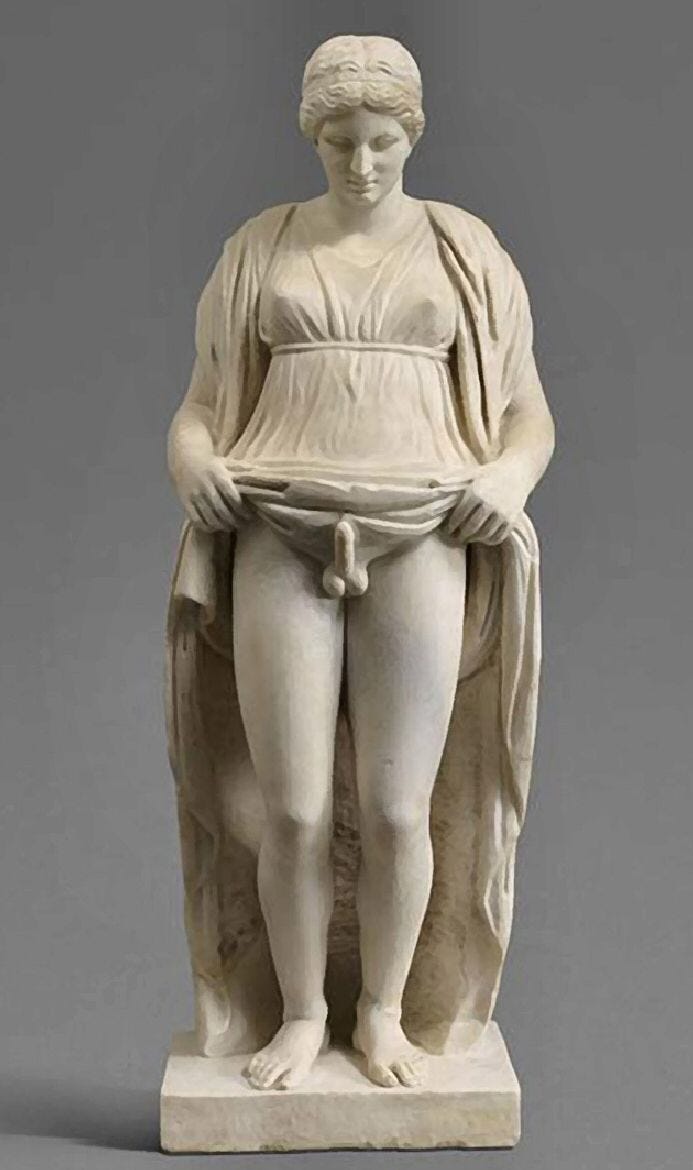Transgendered folk have been a hot topic of conversation recently. They have been coming out of the closet for a generation and in the last few years have achieved the critical mass of a social movement. Trans people are demanding their rights to be out and respected in society and be able to participate in all the normal activities of life.
Cultural and religious conservatives have been screaming bloody murder, making the trans folk out to be mentally ill and a major threat to traditional values. Conservative Christians see the transgender agenda as a useful culture war political fight that will rally their base. Conservatives are pushing bills banning transgendered people from public bathrooms and from competing in sports under their gender identity.
It gets lost in the conversation that transgendered people have a long and profound history with deep traditions in ancient and modern religions. Shamanism goes back to the Ice Age and gender-bending is among the many practices that shamans use to open pathways to the spirit world. For thousands of years, prior to the emergence of our modern religions, trans people were celebrated as high priests in Goddess temples and seen to have unique mystical capabilities.
Transgendered people were pushed underground, out-of-sight, and into the closet in religious wars of the past that created the present order we live in now. It is only in the context of Biblical morality that there is anything even conceptually wrong with transgendered people, other religions simply don’t have a problem with them.
Monotheism became a major social movement in the first millennium BCE, but human history is much older than that. Indigenous peoples and cultures that worship nature and Mother Earth all generally have traditions that see transgendered people as special and blessed with mystical insights.
Trans folks served in the Goddess temples of the Ancient Near East that were forcibly shut down in religious wars spanning centuries, first by the Old Testament Hebrews, then Christians, and later Muslims.
No man whose testicles have been crushed or whose penis has been cut off may enter the LORD's assembly. - Deuteronomy 23:1
Transphobia is deeply rooted in aggressive patriarchal masculinity and the rejection of the Feminine Divine. The logic of monotheism requires that other religious traditions be rejected, especially those of the rival Goddess traditions and Mystery religions.
From the start, monotheistic hardliners condemned certain practices that were core to the Goddess traditions such as free sexual expression for homosexuals and women, the use of psychedelic plant drugs, and nature-based shamanism. Christians worked for centuries to shut down pagan religions and convert indigenous people to Jesus.
Eunuchs are the most visible trans from ancient times. Many men chose to voluntarily castrate themselves in order to serve the Mother Goddess. Not all eunuchs were voluntary though, it was a requirement if one wanted to be welcome within the inner sanctums of the Royal palaces and harems. Only eunuchs could be trusted around the royal women, and this gave eunuchs a unique status as trusted advisors to the kings in many societies.
Many of the ancient pagan Goddess mythologies feature trans and eunuchs as critical characters that established the importance of the transgendered priesthoods. The goddess Isis from Egypt restored her husband Osiris to life after he was murdered and cut into pieces. Isis found all the parts of Osiris except for his penis, which had been eaten by a fish.

In ancient Sumer, the first culture of Mesopotamia that invented writing over 5000 years ago, we see the Assinnu and the Kurgarru. The Assinnu were transgenders much loved by the goddess Inanna/Ishtar. The Kurgarru were transvestite priests who adopted the clothing and manners of women. Ishtar was rescued by eunuchs when she lost her life in the underworld in one important myth.
Ishtar, the Babylonian goddess of love and war, was herself transgendered, and was one of the most popular deities in the Ancient Near East. Ishtar could produce a beard and present as a man when she went into battle. In one lamentation, Ishtar says that she is wise,
“I make right into left. I make left into right. I turn a man into a woman. I turn a woman into a man. I am the one who causes the man to adorn himself as a woman. I am the one who causes the woman to adorn herself as a man.”1
The transgendered Galli priests served the goddess Cybele, the Magna Mater (Great Mother), who was worshipped for over 6000 years beginning in the Fertile Crescent. The cult of Cybele was scandalous in Rome for its wild, orgiastic, ecstatic rituals that were coupled with the festivals of Dionysus.
The Enaree roamed with the nomadic horse-riding Scythians and their Amazon warrior women. Herodotus wrote that they were hermaphrodite shamans blessed by Aphrodite Urania, the Queen of Heaven.
The Greeks and Romans recognized the god Hermaphroditus, the son of Hermes and Aphrodite. He was a remarkably beautiful boy who was merged with a nymph that had fallen in love with him. Hermaphroditus was the god of androgyny and effeminacy and was portrayed as a woman with male genitals.
The biggest and most famous pagan temple in Jesus’s day was the Grand Temple to Artemis at Ephesus. It was one of the seven wonders of the ancient world and was a major pilgrimage spot for centuries. The Megabyzi were transgendered eunuch priests who served Artemis at the Grand Temple.
Jesus identified eunuchs and showed sympathy to them, correctly noting that some were born, some were made by others, and some voluntarily chose castration for the sake of the Kingdom of Heaven. Interestingly though, Jesus does not mention that the main religious reason to become a eunuch in his day was in service of the Goddess temples, not in the Jewish temple.
“For there are eunuchs who were born that way, and there are eunuchs who have been made eunuchs by others--and there are those who choose to live like eunuchs for the sake of the kingdom of heaven. The one who can accept this should accept it." -Matthew 19:12
The ancients believed that transgenders were closer to the divine and that sexuality was sacred, but this was a rival religious tradition to what is taught in the Bible and Koran and was persecuted. Christian and Muslim religions intentionally distanced themselves from the often lustful and ecstatic Goddess worshippers and for centuries attacked homosexuals, transgenders, and prostitutes.
In the Bible, it says that God created people, “male and female” in Genesis, and this is commonly used as an argument by today’s Christians that transgendered people are not legitimate and suffer from mental illness.
So God created mankind in his own image, in the image of God he created them; male and female he created them. - Genesis 1:27
Yet Hinduism recognizes Hijras as a third gender category in law and culture. Trans people have been part of South Asian society forever, but Christian missionaries and the British colonialists viewed them as depraved and worked for centuries to have them criminalized and eradicated.
Christian colonialists and missionaries introduced new sexual mores to the Indian subcontinent that rejected and criminalized homosexuality and outward expressions of gender-bending. Today the Hijras continue to survive, albeit living on the fringes of society and forced into begging and prostitution to earn money.
The debate over transgender rights is fundamentally about religious values. When Christianity became the state religion of Rome in the 4th century, Christians imposed their will on the pagan world by force, closing down the rival temples with violence, murdering priests, smashing artwork, and burning books. Christianity has been waging spiritual warfare ever since, always striving to convert or defeat the heathens.
In America, the fight over transgenders is a fight over whether this will be a Christian nation or not. The religious, conservative right wants to preserve and promote Christianity as much as possible in all walks of life.
The liberal progressive left takes pride in secularism, and for many, atheism. The left does not have a religion or a codified set of common values, but if it did, it would probably celebrate transgenders and the Goddess just as humans have done since the Ice Age.
Launderville, Dale, Celibacy in the Ancient World: Its Ideal and Practice in Pre-Hellenistic
Israel, Mesopotamia, and Greece. Liturgical Press, 2010.





